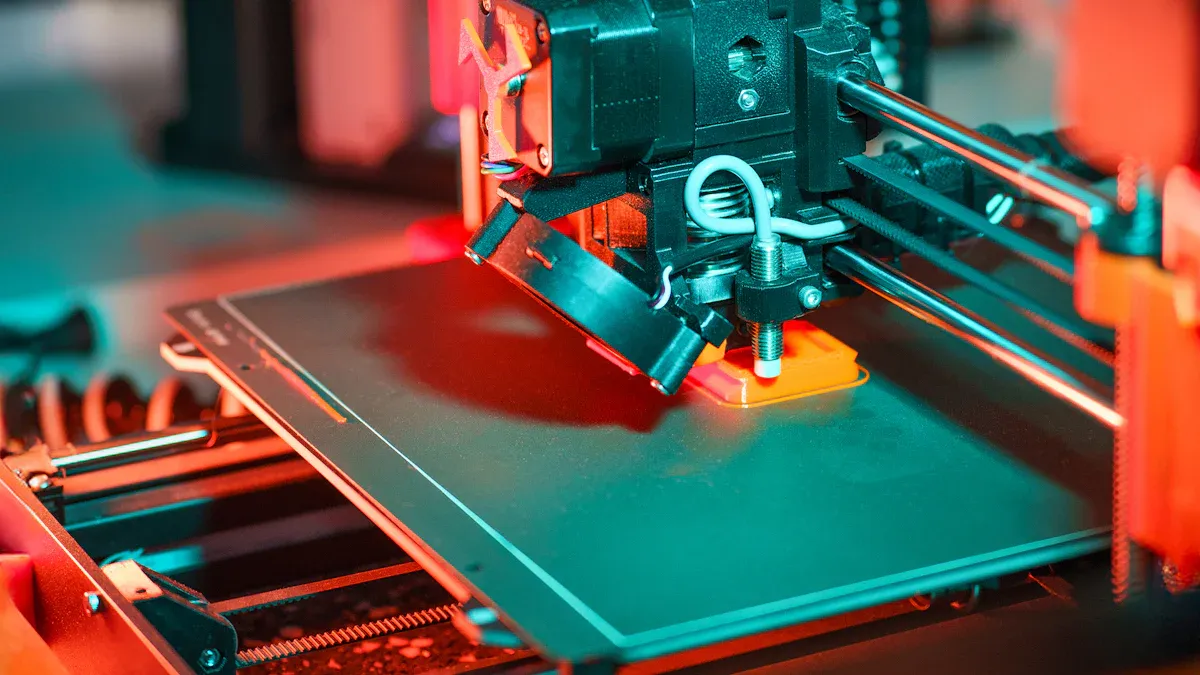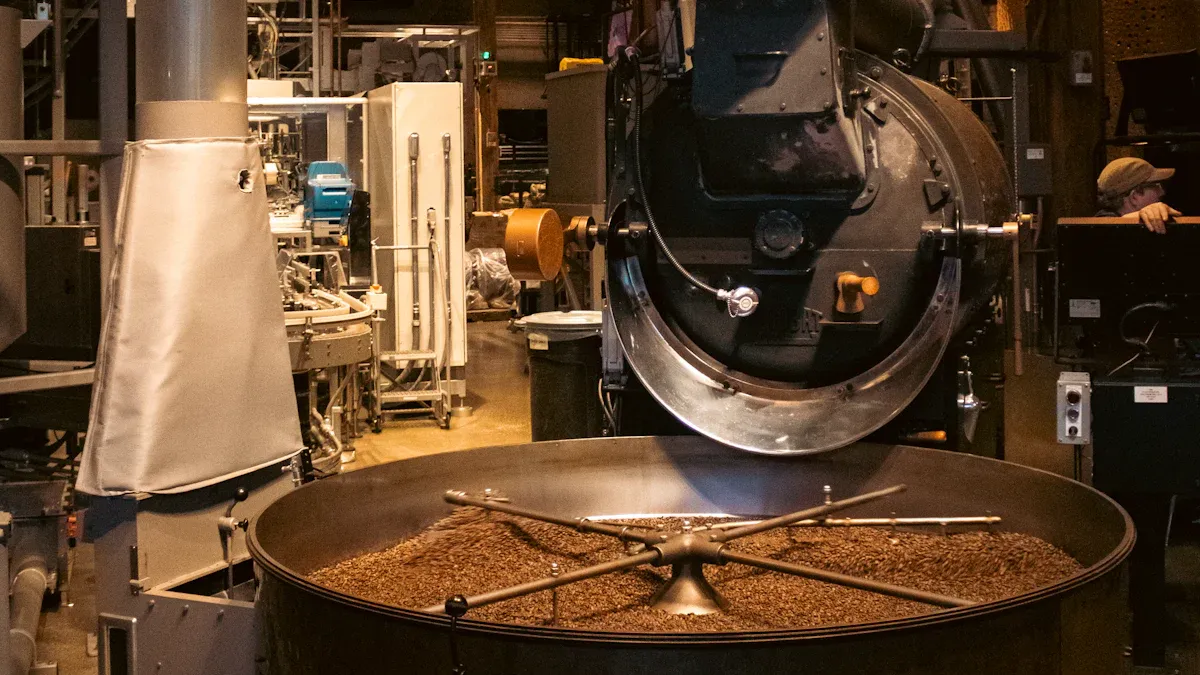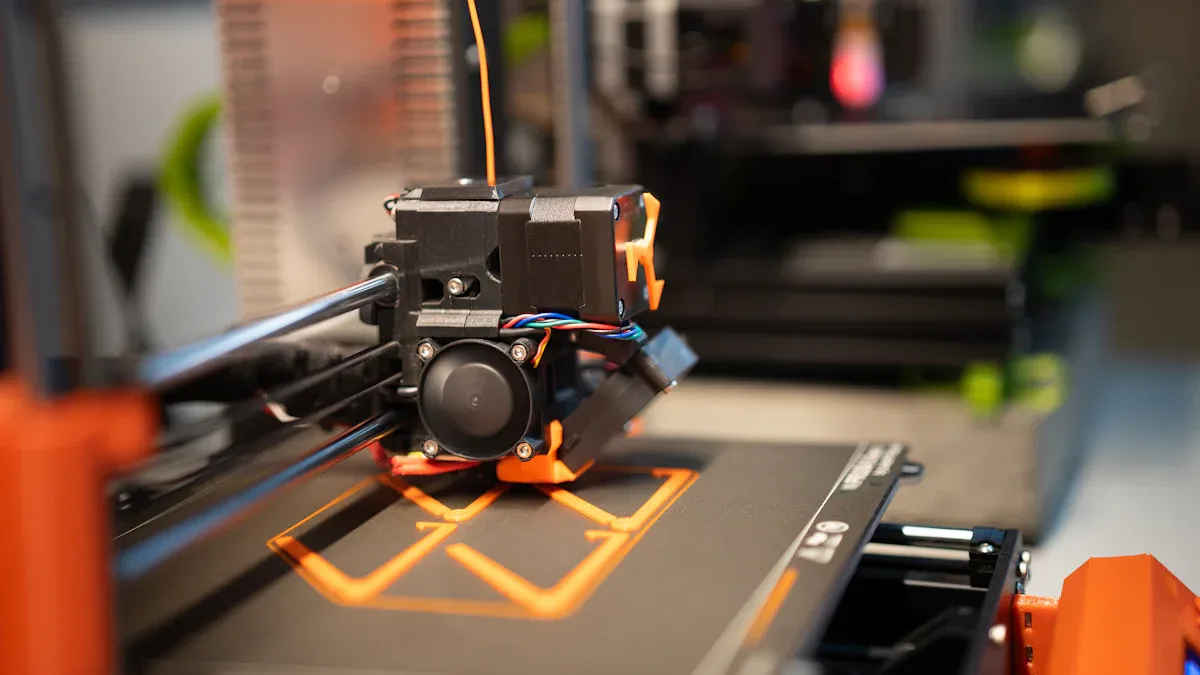
Rapid injection molding plays a crucial role in speeding up your product launch. By significantly reducing production time, it allows you to move from concept to creation faster than ever. For instance, a leading automotive company cut lead times by 60% and reduced R&D costs by 30% using quick-turn molding solutions. Similarly, a consumer electronics brand used rapid tooling to shorten development time by 40%, enabling faster delivery of new product variants. These efficiencies not only save time but also lower costs, giving you a competitive edge in fast-moving markets. Whether you're in new product development or scaling up production, this approach ensures you stay ahead.

Rapid injection molding is a manufacturing process designed to produce high-quality plastic parts quickly and efficiently. It bridges the gap between prototyping and full-scale production, making it ideal for new product development. This method uses rapid tooling techniques, such as aluminum molds and CNC machining, to reduce lead times and costs. Parts can often be produced in less than two weeks, allowing you to bring your product to market faster.
This process is suitable for low to medium production volumes, ranging from a few units to thousands of parts. It also supports intricate designs and customization, making it a versatile solution for industries like consumer electronics, medical devices, and automotive.
Rapid injection molding offers several key features that make it a valuable tool for product development:
- Cost-effectiveness: Aluminum molds lower tooling costs, especially for small to medium production runs.
- Speed and Efficiency: Parts can be produced in days or weeks, significantly reducing time-to-market.
- Design Flexibility: The process accommodates complex designs and allows for quick adjustments.
- Precision and Consistency: It ensures tight tolerances and uniform quality, which are critical for functional parts.
- Sustainability: By minimizing waste and conserving resources, it aligns with eco-friendly manufacturing practices.
| Key Feature | Description |
|---|---|
| Cost-effectiveness | Utilizes aluminum molds for lower costs, especially in low to medium volume production. |
| Versatility | Accommodates a wide range of materials and complex designs, meeting diverse specifications. |
| Improved Precision and Consistency | Produces parts with tight tolerances and uniform quality, ensuring functionality and performance. |
| Enhanced Product Development Flexibility | Allows quick design changes without significant costs, facilitating iterative improvements. |
| Reduction in Time to Market | Speeds up the process from concept to commercialization, providing a competitive edge. |
Rapid injection molding differs from traditional methods in several ways, particularly in speed, cost, and production volume. While traditional injection molding uses steel molds that take 6-12 weeks to produce, rapid injection molding relies on aluminum molds, which can be ready in just 2-4 weeks. This makes it a faster and more cost-effective option for low to medium production volumes.
| Feature | Rapid Injection Molding | Traditional Injection Molding |
|---|---|---|
| Mold Material | Aluminum | Steel |
| Mold Production Time | 2-4 weeks | 6-12 weeks |
| Mold Lifespan | Up to 10,000 parts | 1,000,000+ parts |
| Production Volume | Low to medium (50-10,000 parts) | High (100,000+ parts) |
| Cost for Low Volumes | Lower | Higher |
| Lead Time | Shorter (days to weeks) | Longer (weeks to months) |
If you need a solution for quick prototyping or small-batch production, rapid injection molding is the better choice. However, for high-volume manufacturing, traditional injection molding may be more cost-effective in the long run.
Rapid injection molding accelerates the prototyping process, allowing you to test and refine your designs quickly. By using aluminum or soft steel molds, you can produce prototype molds faster than traditional methods. This speed enables you to create functional prototypes in days rather than weeks, helping you validate your product's design and functionality efficiently.
For example, Norck's rapid prototyping services allow businesses to bridge the gap between design and production. These services enable you to test your product's features and make adjustments without significant delays. Flexible design options, such as interchangeable inserts, make it easier to modify prototypes and incorporate user feedback. This iterative process ensures that your product meets both functional and aesthetic requirements before moving to full-scale production.
Tip: Faster prototyping not only saves time but also reduces costs by identifying and correcting design flaws early in the product development cycle.
Rapid injection molding significantly shortens the time it takes to bring your product to market. Traditional injection molding often involves long lead times for tooling, but rapid prototyping services use advanced technologies to produce molds in just a few weeks. This allows you to launch your product ahead of competitors and capture market opportunities sooner.
New injection molding technologies also support rapid design iteration, enabling you to refine your product quickly. By producing larger quantities of functional prototypes, you can gather valuable insights and validation from testing. Early identification of potential issues minimizes the need for costly revisions later in the production process.
Rapid injection molding offers a cost-effective solution for small to medium production volumes. Unlike traditional methods, which require expensive steel molds, this process uses aluminum molds that are more affordable and quicker to produce. This makes it ideal for businesses looking to manufacture between 50 and 10,000 parts without incurring high upfront costs.
The cost-effectiveness of rapid injection molding becomes evident when analyzing production costs:
| Production Volume | Cost of Mold | Cost per Part | Total Cost of Injection Molding |
|---|---|---|---|
| Low Volume (100 parts) | $100 | $4.5 | $450 |
| Medium Volume (5,000 parts) | $2,500 | $3.0 | $15,000 |
| Large Volume (100,000 parts) | $25,000 | $1.75 | $175,000 |
For small batches, the lower cost of molds and reduced cost per part make rapid injection molding a practical choice. It also allows you to scale production as demand grows, ensuring that your investment aligns with your business needs.
Note: By choosing rapid injection molding for small to medium volumes, you can balance cost and quality while maintaining the flexibility to adapt to market changes.
Rapid injection molding offers unparalleled design flexibility, empowering you to create customized products that meet specific requirements. This process supports intricate designs, quick modifications, and the use of diverse materials, making it ideal for industries that demand precision and adaptability.
One of the standout features of this method is its ability to accommodate advanced molding techniques. For example:
- Overmolding allows you to combine two materials into a single component, enhancing functionality and aesthetics. This technique is commonly used in medical devices to improve grip or add protective layers.
- Insert Molding involves placing a metal insert into the mold before injecting plastic. This creates durable and functional parts, often used in automotive and aerospace applications.
These techniques enable you to produce parts with unique features, such as improved strength, multi-material integration, or enhanced ergonomics.
The flexibility of rapid injection molding also shines in its ability to support iterative design. You can quickly adapt prototypes or small production runs based on user feedback. For instance:
- A medical device company used low-volume molding to create custom diagnostic tools. This approach allowed them to make rapid design changes, reducing both costs and development time.
- An aerospace manufacturer leveraged this process to produce specialized components. They met strict quality standards while keeping costs low and enabling modifications.
- A consumer electronics startup utilized rapid injection molding to refine prototypes. By incorporating user feedback, they perfected their designs before scaling up production.
This adaptability ensures that your product aligns with market demands and customer expectations. Whether you need to test a new design or create a niche product, rapid injection molding provides the tools to bring your vision to life.
Tip: Use rapid injection molding to experiment with innovative designs or materials without committing to high production volumes. This approach minimizes risk while maximizing creativity.

Rapid injection molding has transformed how industries approach production, offering speed, flexibility, and cost-efficiency. Several sectors have embraced this technology to meet their unique demands:
| Industry | Application Examples |
|---|---|
| Automotive | Production of dashboards, door panels, and seat parts. |
| Electronics | Manufacturing of device housings and intricate components. |
| Medical | Creation of syringes, infusion sets, and test tubes. |
| Toy Manufacturing | Enabling intricate designs and vibrant colors in toys. |
In the automotive industry, rapid injection molding supports the creation of lightweight, durable components like dashboards and seat parts. These parts meet strict safety and performance standards while reducing lead times. The electronics sector benefits from the ability to produce complex housings and components for devices, ensuring precision and functionality. For medical devices, this process enables the production of critical items such as syringes and test tubes, where accuracy and sterility are paramount. Even the toy industry leverages this technology to create vibrant, detailed designs that appeal to consumers.
The market data further highlights the growing reliance on rapid injection molding across these industries:
| Industry | Market Value (2024) | Forecast Growth Rate |
|---|---|---|
| Automotive | N/A | 8% |
| Medical Devices | N/A | 8% |
| Consumer Electronics | $1.5 Billion | 5% |
| Consumer Goods | $1.5 Billion | N/A |
These figures underscore the increasing demand for rapid injection molding, particularly in sectors like automotive and medical devices, which are projected to grow at an impressive rate of 8%.
Real-world implementations of rapid injection molding demonstrate its effectiveness in reducing costs and accelerating production timelines. Here are some notable success stories:
| Industry | Improvement Description | Lead Time Reduction | Cost Reduction | R&D Cost Reduction |
|---|---|---|---|---|
| Automotive | Reduced lead times for prototyping engine components | 60% | N/A | 30% |
| Aerospace | Reduced prototyping lead times and costs | 50% | 20% | N/A |
For instance, an automotive company used rapid injection molding to prototype engine components, cutting lead times by 60% and reducing R&D costs by 30%. Similarly, an aerospace manufacturer achieved a 50% reduction in prototyping lead times and a 20% decrease in costs.
Other examples highlight the integration of digital solutions to enhance efficiency. Borgmann GmbH implemented systems that reduced process error analysis and quality inspection times by 30 minutes per machine daily. Additionally, the iQ flow control system improved production stability by reducing temperature control output by 70%. These advancements not only improved product quality but also minimized energy consumption and maintenance efforts.
Rapid injection molding excels in specific scenarios where speed, flexibility, and cost-efficiency are critical. To determine if this process suits your needs, consider the following criteria:
| Criteria | Description |
|---|---|
| Objectives | Define goals and expectations, including design requirements and performance standards. |
| End-Use Application | Choose materials compatible with applications, considering durability and resistance factors. |
| Material Properties | Understand characteristics of materials, such as mechanical and thermal properties. |
| Production Scale | Evaluate the scale and speed of the rapid injection molding process. |
| Expertise | Consult material engineers and industry professionals for informed decisions. |
| Material Compatibility with Tools | Ensure selected materials can be used as tooling in the process. |
| Cost | Assess if the material aligns with the overall project budget. |
This process is ideal for low to medium production volumes, where quick turnaround times and design flexibility are essential. For example, startups launching new products can benefit from rapid injection molding to create prototypes and small batches without incurring high costs. Similarly, industries requiring frequent design iterations, such as medical devices or consumer electronics, can use this method to refine their products before scaling up production.
By aligning your objectives, material choices, and production scale with the capabilities of rapid injection molding, you can maximize its benefits and ensure a successful outcome.
Rapid injection molding speeds up testing and feedback cycles, enabling you to refine your designs more efficiently. By producing prototypes quickly, you can validate concepts and test functionality in real-world scenarios. This process allows you to identify design flaws early, saving time and resources. For example, healthcare professionals often use early prototypes to provide feedback on medical devices, ensuring they perform effectively before full-scale production.
The ability to test multiple design iterations side by side fosters creative experimentation. You can compare different versions of a product simultaneously, making it easier to choose the best design. This approach not only accelerates decision-making but also enhances collaboration among your team. Tangible prototypes improve communication between designers and stakeholders, ensuring everyone aligns with the project’s goals.
| Benefit | Description |
|---|---|
| Quick Validation | Enables rapid testing of design concepts before full-scale production. |
| Reduced Lead Times | Speeds up the initial design and mold creation phases, shortening the overall production timeline. |
| Improved Product Quality | Facilitates early identification and resolution of design flaws, leading to higher quality products. |
| Efficient Market Testing | Allows for quick production of prototypes for immediate feedback and iteration. |
Small-batch production minimizes risks by allowing you to test your designs on a smaller scale before committing to large-scale manufacturing. This approach helps you identify potential issues early, reducing the likelihood of costly mistakes. For instance, rapid injection molding enables you to produce a limited number of parts for testing, ensuring they meet specifications and perform as intended.
By addressing problems during the small-batch phase, you can make informed decisions that mitigate risks. This process also provides an opportunity to gather customer feedback early, refining your product to better meet market needs. Whether you’re launching a new product or updating an existing one, small-batch production offers a low-risk way to ensure success.
Rapid injection molding enhances product quality by enabling thorough testing and validation before full-scale manufacturing. Early prototypes allow you to detect and resolve design flaws, ensuring your product meets both functional and aesthetic requirements. This process reduces the chances of defects in the final product, saving you from costly recalls or revisions.
High-speed iteration plays a crucial role in improving quality. By incorporating user feedback early, you can refine your design to align with customer expectations. For example, a medical device company used rapid prototyping to test diagnostic tools, making adjustments based on user input. This iterative approach resulted in a more reliable and effective product.
Tip: Use rapid injection molding to perfect your design and functionality before scaling up production. This strategy ensures your product meets the highest standards of quality and performance.
Rapid injection molding offers several advantages that can transform your product development process. It reduces lead times, allowing you to move from concept to production in days or weeks. Aluminum molds lower tooling costs, making this method accessible for startups and small businesses. By minimizing material waste and enabling small to medium batch sizes, it also reduces per-unit costs. These benefits make rapid injection molding an excellent choice for faster launches, cost savings, and design flexibility.
Takeaway: Rapid injection molding supports innovation and minimizes risks. Explore this service to bring your next product to market efficiently.
Rapid injection molding usually takes 2 to 4 weeks to produce molds and parts. This is much faster than traditional methods, which can take up to 12 weeks. The quick turnaround helps you launch products faster and stay competitive.
Yes, it supports intricate designs and advanced techniques like overmolding and insert molding. You can create parts with unique features, such as multi-material integration or enhanced ergonomics, making it ideal for industries like medical devices and consumer electronics.
Rapid injection molding works best for low to medium production volumes, typically between 50 and 10,000 parts. For high-volume manufacturing, traditional injection molding with steel molds may be more cost-effective due to their durability and longer lifespan.
You can use a wide range of materials, including thermoplastics like ABS, polycarbonate, and nylon. Material selection depends on your product's requirements, such as durability, flexibility, or heat resistance. Consulting with material experts ensures the best choice for your project.
It uses aluminum molds, which are cheaper and faster to produce than steel molds. This lowers upfront costs, especially for small to medium production runs. Additionally, the process minimizes waste and allows for quick design changes, saving you money in the long run.
Tip: Always evaluate your production needs and budget to determine if rapid injection molding is the right choice for your project.